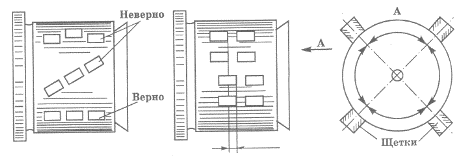Maintenance of the even-collector unit of DC motors
The brush collector in DC machines and other machines is the least reliable assembly and requires careful maintenance. To ensure spark-free operation, a number of conditions must be met to ensure reliable contact between the brush and collector and uniform current capacity of the working surface of the brush.
The serviceability of the even-collector module is checked during the inspection and the necessary measurements. Service manifolds have a smooth surface without protruding mica or loose plates, dents, burn marks, eccentricity or leakage. The brushes slide freely into the clamps of the brush holders without swinging and are pressed against the collector with sufficient force. The bolts, crossmembers, fingers that the brush holders are attached to are pretty stiff and free of vibrations, wobbles, etc. The machine armature is balanced and rotates without vibration. The brushes must be of the same brand, of the required size and ground to the collector.
During maintenance, dust from the collector and the brush mechanism is removed with a vacuum cleaner or blowing with compressed air; the collector is wiped with a napkin moistened with alcohol. Check the ease of movement of the brush in the brush holder.
If the brush moves too much, the brush holder and brush should be cleaned. The distance between the brush holder and the collector should be 2–4 mm for high power DC motors and 1–2.5 mm for low power DC motors.
The clearance of the brush in the socket of the brush holder in the direction of rotation of the collector should not exceed 0.1-0.2 mm for a brush thickness of 8-16 mm and 0.15-0.25 mm for a brush thickness of more than 16 mm.
A large gap causes the brush to tilt due to the frictional force against the collector that carries the lower edge of the brush and makes it difficult to move it into the seat. A large backlash occurs especially in reversible machines, because when the direction of rotation of the brush is changed in the opposite direction, which reduces the surface of its contact with the collector. A gap of 0.2 to 0.5 mm is allowed in the socket along the axis of the collector.
 The pressure of the brush on the collector is also measured. A sheet of paper is placed under the brush and the dynamometer is attached to the brush.
The pressure of the brush on the collector is also measured. A sheet of paper is placed under the brush and the dynamometer is attached to the brush.
The dynamometer reading, where the paper is easily pulled from under the brush, allows you to determine the pressure of the brush on the collector. Insufficient brush pressure leads to severe arcing and accelerated wear of the commutator and brushes. Too much pressure increases the frictional force in the sliding contact, as well as wear.The pressure must be minimal, at which the sparking does not exceed the value allowed by the technical documentation, and the same for all brushes to evenly distribute the current between them. The pressure of the finger on the middle of the brush is adjusted by a spring.
In addition, the correct position of the collector brushes is checked. To evenly load the brushes with current on each brush holder, they are placed strictly along the axis of the collector. For uniform wear of the collector, the row brushes must be offset in the axial directions. The distance between the brush holders is the same.
The leakage of the working surface of the collector is checked with a dial indicator. In order not to distort the measurements of the channel between the collector plates, a flat tip is placed on the end of the indicator rod. The leak is checked in several places while slowly turning the valve. Permissible leakage in high-speed machines with a collector peripheral speed of up to 50 m / s should not exceed 0.02-0.03 mm; on slow-moving machines, considerably more leakage is allowed without affecting the operation of the machine.
When the brushes are manufactured, they are replaced. The size of the permissible power is indicated in the technical documentation for each machine. After installing new brushes, they are pressed and ground. For grinding, a fine-grained glass shell is installed between the brush and the collector and pulled in the direction of rotation of the collector. The working surface of the skin gives the brush a preliminary radius close to the collector radius.
The brush apparatus is then blown with compressed air to remove dust and the brushes are ground while the machine is idling.
Grinding can be considered complete when at least half of the brush surface is in close proximity to the collector. In this case, there should be varnish on the collector. If the collector has scratches, light burns, they are removed by grinding the collector.
